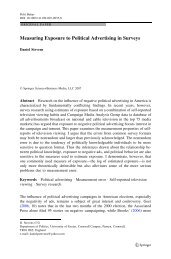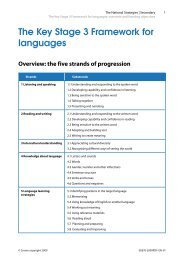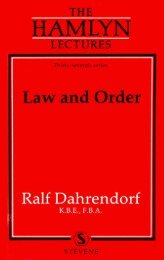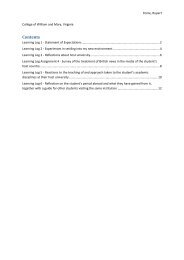speech and respect - College of Social Sciences and International ...
speech and respect - College of Social Sciences and International ...
speech and respect - College of Social Sciences and International ...
Create successful ePaper yourself
Turn your PDF publications into a flip-book with our unique Google optimized e-Paper software.
Taking Sides<br />
first director <strong>of</strong> the Smithsonian's National Museum <strong>of</strong> the American<br />
Indian, declared: "No other modern museum has so self-consciously<br />
sought focused input <strong>of</strong> special concerns from a user population." 12 <strong>of</strong><br />
the 25 governing board members must be Indian. "We're part <strong>of</strong> the 'we,'<br />
not the 'them.' " A pre-opening show in New York, "Pathways <strong>of</strong><br />
Tradition," was shaped by the recommendations <strong>of</strong> 28 "culturally based"<br />
artists, religious leaders, educators, <strong>and</strong> museum administrators. New<br />
York Times s.2 p.53 (September 13, 1992).<br />
91 New York Times M (March 2, 1992).<br />
Many African Americans have condemned Huckleberry Finn as racist,<br />
deploring Mark Twain's use <strong>of</strong> the word "nigger" (200 times) <strong>and</strong> urging<br />
its exclusion from schools <strong>and</strong> libraries. Now a white literature pr<strong>of</strong>essor<br />
has found an 1874 article in which Twain identified a 10-year-old black<br />
boy as the inspiration for Huck's <strong>speech</strong> patterns. Henry Louis Gates Jr.,<br />
an African American pr<strong>of</strong>essor <strong>of</strong> literature at Harvard, commented:<br />
"What we discover after all this time is that it is the black American<br />
linguistic voice which forms the structuring principle <strong>of</strong> the great American<br />
novel, <strong>and</strong> that ain't bad." New York Times A1 (July 7, 1992); Fishkin<br />
(1993).<br />
92 New York Times B9 (December 1, 1989), B2 (December 4, 1989).<br />
Evanston, Illinois, planned a public service announcement on television,<br />
created free <strong>of</strong> charge by a Chicago advertising executive. It began with a<br />
neo-Nazi giving the Sieg Heil salute while a voice over said "If they gave<br />
a medal for killing black people, this gang would win a bronze" for 12<br />
murders in the last decade. Then the hooded Ku Klux Klan appeared with<br />
a torch while the voice over said: "This gang would win the silver" for 20<br />
murders in the last three decades. Finally a young tattooed black man<br />
wearing a baseball cap, cut<strong>of</strong>f shorts, heavy jewellery, <strong>and</strong> a tank top<br />
appeared with sounds <strong>of</strong> gunfire in the distance while the voice over said<br />
"But this gang would win the gold. If you're in a gang, you're not a<br />
brother. You're a traitor." The screen showed 1300 murders in 1991<br />
alone. A black city councillor condemned the ad, while the head <strong>of</strong> the<br />
Police Department gang unit endorsed it. New York Times s.1 p. 10<br />
(August 23, 1992).<br />
93 A judge has since held that the Alderman violated the student's constitutional<br />
rights <strong>and</strong> ordered the policemen to st<strong>and</strong> trial. New York Times A9<br />
(August 12, 1992).<br />
In Negrophobia, a black author wrote the story <strong>of</strong> a white teenager<br />
transported to a world where the most bigoted stereotypes prevail. A<br />
white artist designed the cover, showing a scantily clad white girl with the<br />
shadow <strong>of</strong> an oversize black caricature peering over her shoulder. A<br />
black woman employee <strong>of</strong> the publisher was enraged: "it gives credence<br />
to the old stereotypes that too many people still believe." The publisher<br />
had anticipated that "less hip" readers might be "turned <strong>of</strong>f" but concluded<br />
that "this was an appropriate reflection <strong>of</strong> the parody in the book."<br />
The author explained:<br />
162

















